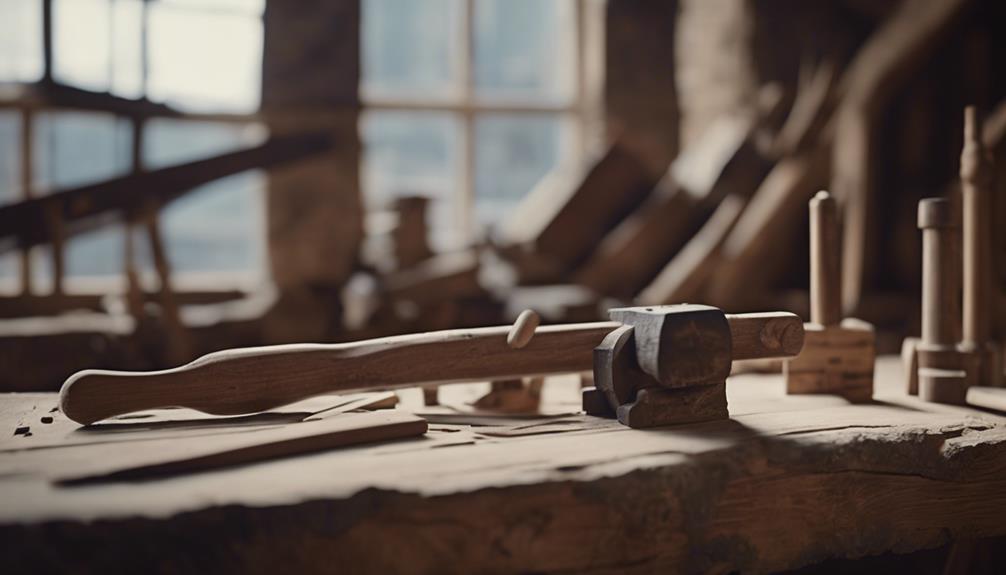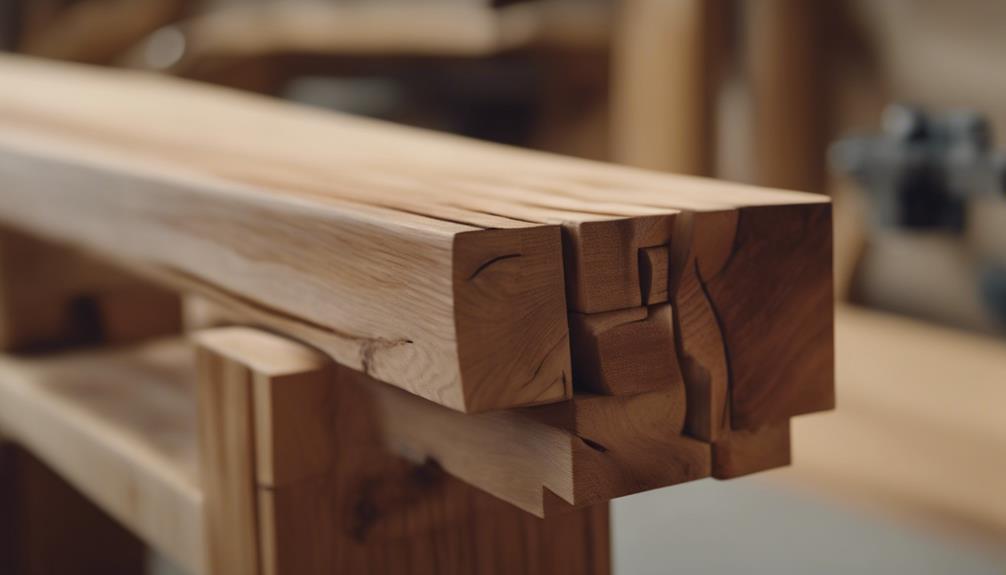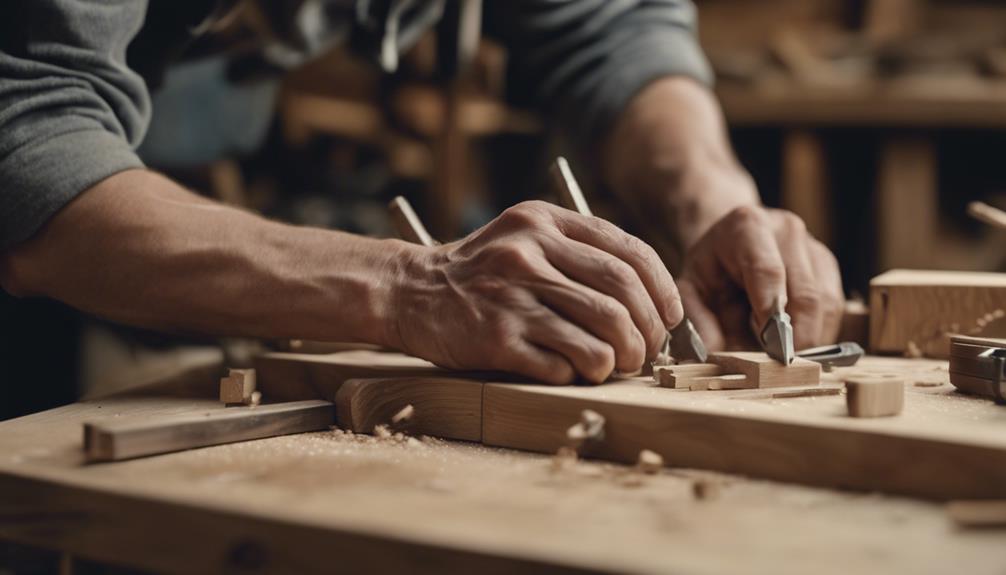Exploring through the world of woodworking, we often come across the mortise and tenon joint, a cornerstone that has upheld structures and furniture with a grip as firm as history itself. We've found its simplicity masks a depth of technique and versatility, making it a favorite among craftsmen.
In our exploration, we'll uncover the evolution of this ancient method, breaking down its principles and revealing the variety it offers. From the advantages that make it a go-to solution to the challenges that test the skills of even seasoned woodworkers, we invite you to join us as we uncover why this technique remains indispensable in modern woodworking, hinting at innovations that may reshape its future.
Key Takeaways
- The mortise and tenon joint technique has a rich history, dating back thousands of years and used by ancient civilizations.
- It is renowned for its strength, durability, and versatility in woodworking projects, without the need for metal fasteners.
- There are various forms of mortise and tenon joints, each offering unique advantages for different woodworking applications.
- Crafting mortise and tenon joints requires precision, attention to detail, and specific tools, presenting a learning curve for beginners.
History of Mortise and Tenon

Tracing back thousands of years, the mortise and tenon joint has anchored the art of woodworking with its robust and intricate design. We've seen evidence of this technique in the remnants of ancient civilizations, proving its enduring presence in our history. The Egyptians, renowned for their architectural and woodworking mastery, extensively utilized this joint in their furniture and building constructions. It's fascinating to think that the chairs we sit in today owe their durability to methods developed over 7,000 years ago.
Moving forward in time, the Greeks and Romans adopted and refined the mortise and tenon, integrating it into their own creations. They recognized its strength and versatility, qualities that have carried through to modern carpentry. We've inherited this legacy, and it's a confirmation to the joint's timeless efficacy.
As we explore further into the history of woodworking, it's clear that the mortise and tenon isn't just a technique; it's a bridge connecting us to our past. We're not just crafting furniture; we're continuing a tradition that's as old as civilization itself, ensuring that the skill and artistry of our ancestors carry on through our hands.
Basic Principles Explained
Before delving into the intricate process of creating mortise and tenon joints, grasping their fundamental principles is essential. We'll break down these essentials, making sure we're all on the same page.
This joint technique, one of the oldest in woodworking, hinges on two components fitting perfectly together to form a strong bond without the need for metal fasteners. Understanding the basics not only sets the groundwork for learning more complex variations but also enhances our appreciation for this time-honored craft.
Here are three key principles we must understand:
- Precision is essential: The success of a mortise and tenon joint relies heavily on the accuracy of the cuts. The mortise (hole) and the tenon (tongue) must fit snugly, leaving no room for play or gaps.
- Strength comes from the fit: The interlocking nature of the joint provides remarkable strength and durability, making it ideal for load-bearing applications such as furniture and building construction.
- Adaptability is key: While the basic concept remains the same, the mortise and tenon joint can be adapted to suit a variety of needs and applications, making it incredibly versatile.
Types of Mortise and Tenon Joints

As we explore the various types of mortise and tenon joints, it's clear that each style offers its unique advantages tailored to different woodworking projects.
First, we've got the standard mortise and tenon joint, which is the backbone of many classic furniture pieces. It's straightforward but incredibly strong, making it ideal for structural applications.
Then there's the through mortise and tenon, where the tenon goes completely through the mortise. This not only adds strength but also allows for an attractive design element when the end of the tenon is visible.
We also can't overlook the wedged tenon, which involves a wedge driven into the end of the tenon after assembly. This creates a tighter fit and adds visual interest. Similarly, the tusk tenon joint uses a wedge to secure the tenon, but in this case, the wedge is visible on the outside, offering both an aesthetic and functional benefit.
Finally, the dovetail tenon, which combines elements of both the dovetail joint and the mortise and tenon, provides exceptional resistance to being pulled apart. It's particularly useful in side-to-side connections where strength is paramount.
Each of these types serves specific needs in woodworking, offering a range of options for joinery that's both strong and visually appealing.
Advantages of This Technique
The mortise and tenon joint technique boasts numerous advantages, including unparalleled strength and versatility in various woodworking projects. We've found it to be a cornerstone in creating durable and lasting furniture. Its historical use across cultures speaks volumes about its reliability and the trust craftsmen place in it. Beyond its strength, this technique offers flexibility in design, allowing us to tackle a range of projects with confidence.
Here are three key advantages we've identified:
- Durability: The interlocking nature of the mortise and tenon joint creates an incredibly strong bond that's resistant to being pulled apart. This means furniture and structures can withstand heavy use and the test of time.
- Versatility: Whether we're working on chairs, tables, or even more complex structures, the mortise and tenon joint adapts beautifully. Its application isn't limited by the scale of the project, making it a go-to choice for a variety of woodworking tasks.
- Aesthetic Appeal: There's a certain elegance to the simplicity of this joint. It can be adjusted to be nearly invisible or featured as part of the design, giving us the flexibility to match the joint to the aesthetic we're aiming for.
Challenges in Crafting

While we've explored the significant benefits of the mortise and tenon joint technique, it's important to acknowledge the challenges craftsmen face in perfecting this method. One of the primary hurdles is achieving precise cuts. The mortise and tenon must fit together perfectly; even a slight misalignment can compromise the joint's strength. This level of precision requires not only skill and experience but also patience and attention to detail.
Additionally, there's the challenge of selecting the right tools. While traditional hand tools like chisels and saws offer control, they demand a high level of expertise and significantly more time. On the other hand, power tools speed up the process but can be less forgiving, making it easy to overcut or damage the wood.
Material selection also plays a crucial role. Different wood types react differently under stress and with changes in humidity and temperature. Choosing the wrong type of wood can lead to joints that are too tight or too loose over time.
We've also found that the learning curve for mastering this joint can be steep for beginners. It's not just about cutting and fitting; understanding wood grain direction, proper tool use, and joint placement requires comprehensive knowledge and experience.
Comparison With Other Joinery Methods
When comparing mortise and tenon joints with other joinery methods, it's important to evaluate their unique strengths and limitations. This traditional technique, known for its strong, interlocking design, offers a distinct set of advantages and challenges when placed side by side with alternatives like dovetails, biscuits, or pocket screws.
To better understand these differences, let's consider:
- Strength and Durability: Mortise and tenon joints excel in creating strong, enduring connections. Unlike biscuit or pocket screw joinery, which rely on glue and mechanical fasteners, the interlocking nature of mortise and tenon provides a robust bond that withstands stress and wear over time.
- Aesthetics: For projects where the appearance of the joints is crucial, the mortise and tenon technique offers a clean, classic look that's hard to beat. In comparison, methods like pocket screws often require hiding the joinery for a polished finish.
- Skill and Equipment: Crafting mortise and tenon joints demands a higher level of skill and specific tools compared to simpler methods like biscuit joinery. This can be a barrier for beginners but also allows for greater precision and craftsmanship in the hands of experienced woodworkers.
Tips for Perfect Execution

Having explored the unique characteristics of mortise and tenon joints compared to other methods, let's now focus on mastering their execution with practical tips. Achieving perfection in creating these joints isn't just about skill but also about the nuances that make all the difference. Here's a table to guide us through some key tips:
| Tip | Why It's Important | How to Implement |
|---|---|---|
| Measure Twice, Cut Once | Ensures accuracy, reducing waste. | Use precision tools for marking and measuring. |
| Use Sharp Tools | Clean cuts prevent weakening the joint. | Regularly sharpen chisels and saws. |
| Test Fit | Identifies issues before final assembly. | Assemble without glue to check fit. |
| Apply Glue Sparingly | Excess glue can weaken the joint. | Use a small brush or fingertip for application. |
We've learned that attention to detail is crucial. Measuring accurately ensures that our joints fit seamlessly, thus avoiding unnecessary waste. Sharp tools help us make precise cuts, which is vital for the joint's integrity. Test fitting before the final assembly allows us to spot and rectify any potential issues, ensuring a snug fit. Lastly, applying glue sparingly prevents weakening the joint and ensures a clean finish. Let's remember these tips as we strive for perfection in our woodworking projects.
Future Trends in Wood Joinery
As we look ahead, emerging technologies promise to revolutionize the way we approach wood joinery, making it more efficient and accessible. We're on the brink of a new era where traditional skills merge with innovative tools and materials, enhancing our ability to create with wood in ways we've only imagined.
Here are three key trends we're excited about:
- Digital Fabrication Techniques: We're seeing a surge in the use of CNC machines and 3D printers in wood joinery. These tools allow for precise cuts and shapes that were previously impossible or too time-consuming to achieve by hand. They're opening up new design possibilities and making intricate joinery more accessible to everyone.
- Eco-friendly Adhesives and Materials: As we all become more conscious of our environmental impact, there's a push towards sustainable practices in all areas of woodworking. We're exploring biodegradable glues and recyclable composite materials that can complement or even replace traditional wood in some joinery applications.
- Smart Joints: Imagine joinery that can adjust itself based on environmental conditions or wear over time. We're not there yet, but research into smart materials and responsive wood joinery is underway. This could lead to furniture that lasts longer and adapts to its surroundings, reducing waste and saving resources.
We're standing at the threshold of a new frontier in wood joinery, and we can't wait to see where these trends take us.
Frequently Asked Questions
Can Mortise and Tenon Joints Be Effectively Used in Modern Automated Manufacturing Processes, or Are They Primarily Suited for Handcrafted Projects?
We're wondering if these joints can integrate well with today's automated manufacturing or if they're really best for handcrafted work. It's an interesting balance between traditional craftsmanship and modern production techniques we're looking to explore.
How Does the Environmental Impact of Creating Mortise and Tenon Joints Compare to Other Joinery Techniques, Particularly in Terms of Material Waste and Energy Consumption?
We're curious about how the environmental footprint of creating these joints stacks up against other methods, especially regarding material waste and energy usage. It's an important aspect to take into account for sustainable building practices.
Are There Specific Wood Species That Perform Better With Mortise and Tenon Joints, and How Does the Choice of Wood Affect the Joint's Durability and Aesthetic Appeal?
We're wondering if certain types of wood work better for these joints, affecting their strength and look. It's interesting how the wood choice impacts both the durability and aesthetic appeal of the finished piece.
How Have Digital Tools and Software Impacted the Design and Precision of Mortise and Tenon Joints in Contemporary Woodworking and Furniture Design?
We've found that digital tools and software greatly enhance the precision and design of joints in modern woodworking. They make it easier to achieve perfect fits, boosting both durability and the overall aesthetic quality.
Can the Principles of Mortise and Tenon Joinery Be Adapted for Use With Materials Other Than Wood, Such as Composite Materials or Metals, and What Are the Considerations in Doing So?
We're wondering if we can adapt mortise and tenon joinery for materials like composites or metals. There'd be lots to contemplate, such as material compatibility, structural integrity, and the tools needed for these adaptations.




